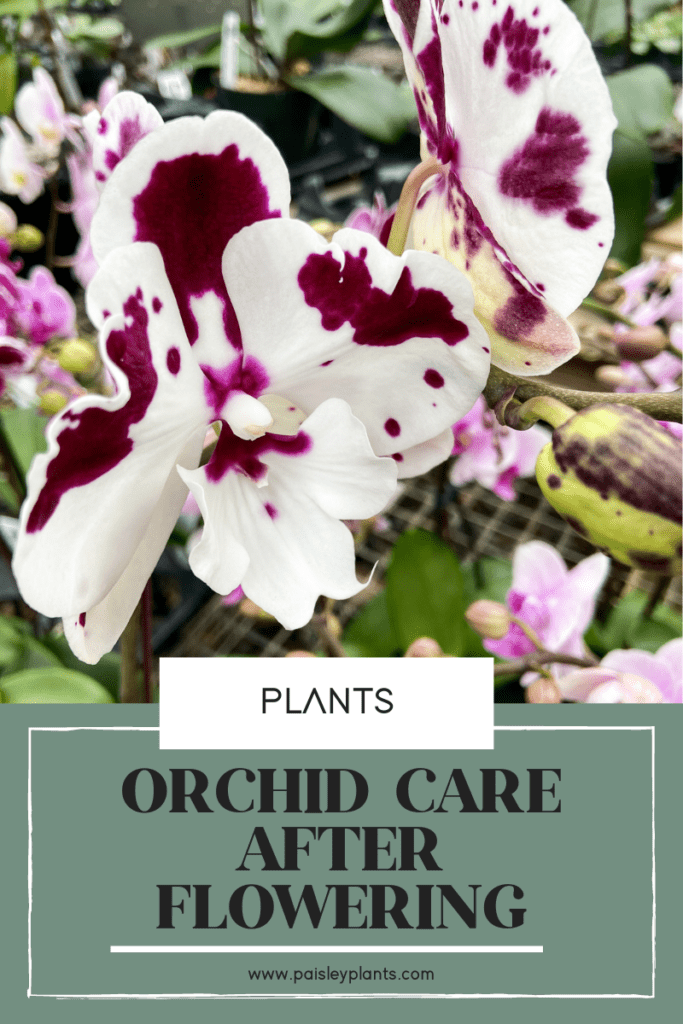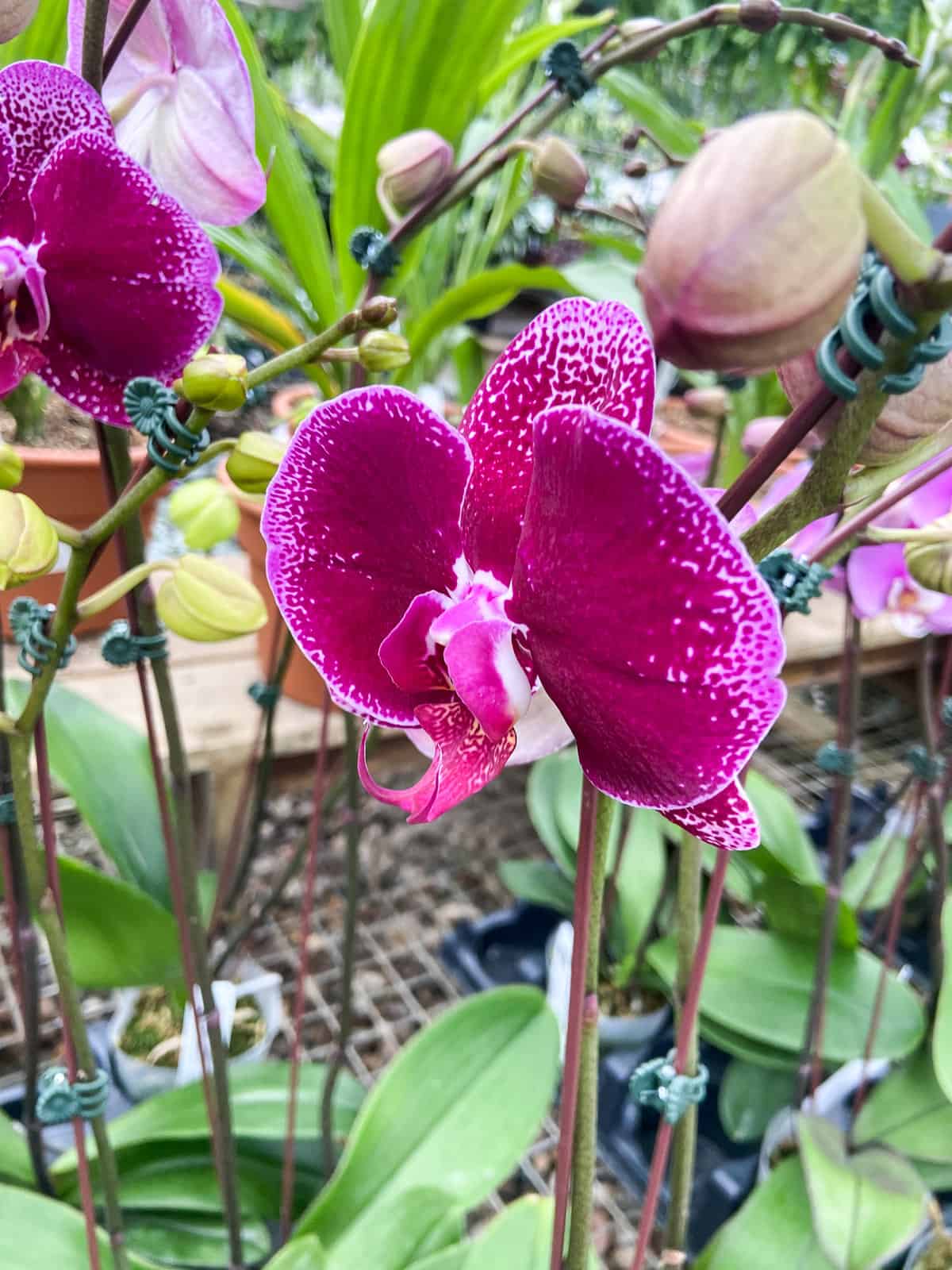Caring for an orchid plant is no small task. Orchids have built up quite the reputation for having very lofty care requirements. So it comes as no surprise that there is particular orchid care after flowering.
This all may sound a bit intimidating, but don’t worry – we’re here to help! Read on for tips on orchid care after flowering, as well as advice on how to get your orchids to bloom again.

Table of Contents
Background
Orchids are undoubtedly one of the most easily recognizable and famous flower species in the world. Their uniqueness and tricky care requirements has earned orchids a cult-like following, with many plant owners jumping through hoops to be able to make their orchids bloom.
Orchids are classified as an epiphyte. An epiphyte is a type of plant that does not grow in your regular soil mix. Instead, orchids prefer to grow off of other objects, namely tree bark.
While orchids tend to use other plants in the wild to grow off of, they are not parasitic and their presence is benign to other plants, which is good to know when you plan on bringing an orchid into your home or garden.
How Long Does a Flowering Bloom Last on Orchids

Orchid blooms can last quite a long amount of time and bring beauty to any space in your home. On average, an orchid bloom lasts approximately 6 to 8 weeks long before it begins to fade. Which is understandable why plant owners want to keep the beautiful orchid flower blooms around for as long as possible.
Orchid Care After Flowers Fall Off
While orchid flowers are always very enjoyable, there comes a time when the bloom fades and your left wondering what to do afterwards. Here are three options you can take when it comes to removing your faded orchid bloom.
Option 1: Leave it Alone
One option is not recommended for reblooming purposes nor aesthetics. This method is very straightforward; you simply leave the entire stem intact after the flower falls off.
Some buds might form at the tip of the stem. However, the stem will grow long and leggy, and the flowers that will develop after will be much smaller.
Again, this is not recommended when it comes to tending to the orchid bloom, though it is a possibility. Let’s move on to some more productive methods of pruning your orchid blooms.
Option 2: Cut the Stem
Our second technique is to cut the orchid stem off after the flower blooms. This technique is viable if you still have a healthy orchid flower spike that has the strength to produce a new flower. If your flower spike is firm and green in color, then those are very good signs you still have a healthy flower spike.
You’ll want to cut the stem right above the node of the plant. You’ll be able to easily spot nodes on your orchid; they look like a raised bump covered with a pointed triangle cover. Cut one to two nodes down; make sure to leave a little room and don’t cut right at the node or stalk.
This is good because it extends the flowering and growing season of your orchid. That way, you won’t have to wait another year for a new flower spike on your orchid to form.
On occasions, your orchid plants will start growing new stems out of the node and will bloom again. Though please keep in mind that this is not a guarantee. Only certain types of orchids will rebloom, such as the moth orchid or the phalaenopsis orchid.
All other varieties of orchid enter a dormancy period to recover their energy, or will grow one new bloom from a new spike.
It takes about 8 to 12 weeks for one flower spike to form on a phalaenopsis orchid. The flowers that grow from the second blooming tend to be smaller on the orchid. This is because the orchid uses less energy to rebloom the flower than it did during the initial bloom.
In addition, the stem color on the orchid begins to dull into a murkier swamp green.
Option 3: Cut the Entire Orchid Flower Spike
The entire orchid spike should be cut off after the stem has started to turn yellow/brown and dry up. These orchid flower spikes are far too weak to rebloom and it is best to remove them entirely from your plant in order to increase the chances of a healthy growing orchid.
Take your shears and start cutting at the base of the orchid stem, as close to the bottom of the plant as possible. Please make sure that you do not damage any of the stalk, leaves, roots, flowers, or other parts of the orchid as you do this to your plant.
After removing the entirety of the spike, new roots and foliage growth should start to form on your orchid since you have removed the spike from the plant.
General Care Guide After Flower Blooming

Reduce infection.
When it comes to blooms orchid care, regardless of whether you choose to prune just a few nodes or an entire stem or leaves of your orchid, you’ll want to cauterize the cut-end of the orchid to prevent the possibility of your orchids contracting an infection.
If your orchid has been infected by fungal or bacterial diseases, trimming the leaves may be another solution to help saving the plant.
The most popular method of cauterizing the stem on an orchid is by dusting cinnamon powder on the stem. Dip a cotton swab in cinnamon and gently rub it on the cut-end of the orchid stem, never ever dust cinnamon on the orchid roots.
When it comes to one of the other methods of orchid care, you may have heard of other gardeners having used candle wax in the past to cauterize the cut.
However, we reply to those gardeners by saying that the danger of putting a hot object near your delicate orchids or any type of plant is extremely risky.
For this reason, it is not recommended to use candle wax on your orchid. Simply using cinnamon powder is a much less risky technique to reduce infection on your orchid.
Check to see if your orchid plant need to be repotted.
The ideal time to repot your orchids is after all flowers finished blooming and growing and have fallen off and you’re left with a bare spike in the pot. Orchids do not need to be repotted every year, especially after placing them in a high-quality potting mix.
Orchids enjoy a chunky, aerated potting mix (which you can buy from your favorite local nursery or home improvement store); over time, this mix is one of their favorites because it breaks down and causes it to become more compact and trap water.
Since a higher quality potting mix is less likely to break down easily, it allows your orchids to go anywhere from 2 to 5 years without needing to be placed in a new pot.
Apply a fertilizer.
Another piece of important orchid plant care is that they should not be fertilized at all during the blooming period; rather, the ideal time to fertilize your orchid is after blooming. Orchids use a significant amount of energy to create these blooms.
Applying fertilizer to your orchids after blooming is an excellent way to help your plant replenish its energy after blooming.
Select a fertilizer that has an NPK ratio of 20-20-20 and dilute the fertilizer to half of what the recommended dosage is for your orchid. Apply this fertilizer solution on your orchid once a month.
Lower the air temperature.
Moving your orchid to a cooler area of your home is one way to increase the likelihood of a second blooming. Blooming and growing can be induced if you move your orchid to a location that receives nighttime temperatures of roughly 55° F.
The shift of temperature from 55° F to ~80° F during the daytime can send signals your orchid which can encourage it to start growing flowers.
Reduce your orchid’s water intake.

Most orchids can survive for two to three weeks without water, sometimes even up to one month. Cattleyas and Phalaenopsis will survive with up to three weeks with no water, as long as their soil is moist.
Orchids (particularly cattleyas and dendroblums) tend to absorb less water immediately after blooming.
It is also important to examine your orchid’s leaves to judge the appropriate water intake. In order to fix limp orchid leaves, the process begins by examining the orchid’s roots and then by learning how to correctly water.
In order to protect your roots, you must conserve how much water you give your orchids. Giving your orchid too much water during this sensitive time period can heighten the risk of root rot on your plant.
You will notice that your orchid has root rot if it has mushy roots. The color of the roots on your orchid says a lot about its health; healthy roots will be plump and green. If your orchid has dry roots, take steps immediately to rehydrate your plant.
The Phalaenopsis orchid needs to be given water as normal since the time it takes for their soil to dry out can take longer than usual. Following this water schedule will ensure that your orchid does not experience root rot or any other issues with the roots down the road.
Where to Buy
Orchids have a reputation for being difficult plants to care for, but I think this is simply unfair. Yes, orchids have some high expectations when it comes to plant care, but who can blame them?
As soon as you follow these steps for orchid care after flowering and see the beautiful blossoms brighten up your home, you’ll soon realize that all of that hard work was worth it!
FAQ
The key to achieving a rebloom lies within meticulously caring for your orchid plants. Part of the growing responsibility of owning orchids is always ensuring that they are receiving the utmost care before and after flowering.
After the first bloom, prune your orchid stems if need be; this plays a large role in the possibility of a future reblooming.
In addition, following the other care advice we’ve discussed previously will put your orchid plants on the right track to blooming and growing again.
This depends on the health of your orchid stem. In terms of bloom orchid care, if the stem has weakened and turned yellow/brown in color, then it is best to prune the flower spike all the way towards the base of the orchid.
If the flower stem is still green and healthy, then only cut above the first node on the stem of the orchid.
This is entirely dependent on the orchid itself. Though on average, orchids typically take between three to six months before you see a new flower bloom. Please do keep in mind, that this is not a guarantee and reblooming an orchid is heavily reliant on intense care of the orchid.
Do not feel discouraged if it is taking a while for your orchid to flower again; simply continue giving your orchid the white glove treatment it deserves and you’ll be rewarded with another round of beautiful flowers on your orchid.
Looking for more orchid fun? Head on over to these posts!

